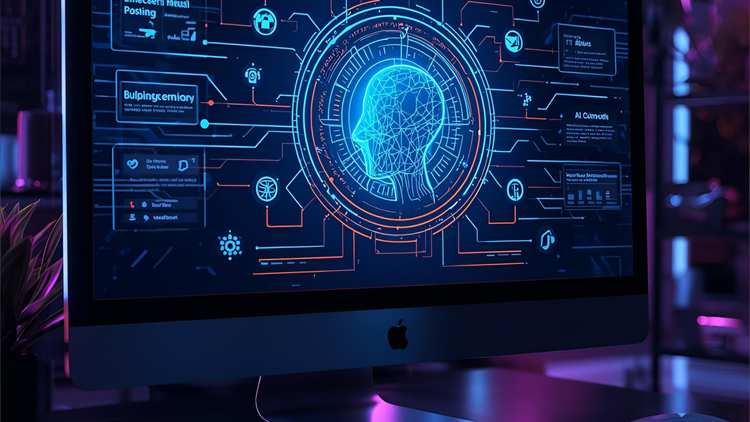
Managing social media presence across multiple platforms consumes hours that most tech companies can't spare. Between crafting platform-specific content, maintaining consistent posting schedules, and adapting messaging for different audiences, social media management often becomes a bottleneck rather than a growth driver.
Generative AI fundamentally changes this equation. By combining AI content generation with automated posting workflows, you can maintain an active social media presence without dedicating entire teams to content creation. This guide shows you how to build practical social media automation workflows that leverage AI while maintaining authenticity and brand voice.
Understanding Social Media Automation Workflows
A complete social media automation workflow consists of three core components: content generation, scheduling logic, and distribution mechanisms. Each component requires thoughtful configuration to produce results that feel human rather than robotic.
The content generation layer uses AI models to create posts, captions, and visual concepts based on your brand guidelines and source material. Scheduling logic determines optimal posting times and frequency across different platforms. Distribution mechanisms handle the technical work of publishing content to each social network through their respective APIs.
Modern AI powered social media tools have evolved far beyond simple template filling. Models like GPT-4 and Claude can analyze your existing content to understand voice and tone, then generate new material that matches your brand personality. The Stanford Internet Observatory research indicates that well-configured AI content systems can match human-quality outputs for informational and promotional content when properly supervised.
The key distinction between effective and ineffective automation lies in how you structure the workflow. Simply generating random content and posting it accomplishes little. Successful automation requires strategic planning about what content serves your audience, how AI fits into your broader marketing strategy, and where human oversight remains essential.
Building the Content Generation Engine
Start by creating a content framework that guides your generative AI for social media. This framework should include your brand voice guidelines, key messaging themes, topics to cover, and examples of high-performing posts from your history.
Structure your AI prompts to produce content aligned with specific marketing objectives. If you're announcing a new product feature, your prompt should instruct the AI to highlight benefits, include relevant technical details, and incorporate a clear call to action. For thought leadership content, prompts should emphasize insights, industry trends, and your unique perspective.
Implement a content calendar that maps topics to specific dates and platforms. Your automation workflow can then query this calendar and generate appropriate content for upcoming slots. This approach maintains strategic coherence rather than producing disconnected posts.
Use AI to generate multiple variations of each core message, then employ automated selection criteria or human review to choose the strongest version. Creating five options and selecting the best performs significantly better than accepting the first AI output.
For visual content, AI image generators can create graphics, illustrations, or concept art that complements your text posts. Tools like DALL-E or Midjourney integrate into automation workflows through their APIs, though visual content typically requires more human oversight than text to ensure brand consistency and quality standards.
Designing Platform-Specific Automation
Each social platform has distinct characteristics that your automated content creation tools must accommodate. LinkedIn favors professional insights and longer-form content, while Twitter rewards concise observations and timely commentary. Instagram prioritizes visual storytelling, and Facebook suits community engagement and detailed updates.
Build separate content generation prompts for each platform that account for these differences. Your LinkedIn automation might produce 150-word posts with professional language and industry terminology. Twitter automation should create concise observations with natural conversational tone. Instagram automation needs to generate engaging captions that complement visual content.
Character limits, hashtag conventions, and optimal content formats vary across platforms. Your workflow should automatically format content appropriately, adding relevant hashtags to Instagram posts, threading related tweets together, or including professional credentials in LinkedIn content.
The Pew Research Center's social media usage data shows that audiences expect different content types on different platforms. Users turn to LinkedIn for professional development, Twitter for news and quick updates, and Instagram for visual inspiration. Your automation should respect these usage patterns rather than cross-posting identical content everywhere.
Implementing Multi-Platform Posting Automation
Once you've generated platform-specific content, you need reliable distribution mechanisms. Social media API integration allows your workflows to publish directly to each platform without manual intervention.
Most major platforms offer official APIs for posting content programmatically. Twitter's API, LinkedIn's Publishing API, Facebook's Graph API, and Instagram's Basic Display API all support automated posting with proper authentication. Buffer and Hootsuite offer unified APIs that simplify multi-platform distribution if you prefer working through intermediary services.
Build your auto posting tool with proper error handling. Social media APIs sometimes experience downtime or rate limiting. Your workflow should detect failed posts, queue them for retry, and alert you to persistent issues rather than silently failing to publish content.
Implement scheduling logic that posts at optimal times for each platform. LinkedIn typically sees higher engagement during business hours on weekdays, while Instagram performs better during evenings and weekends. Your automated social media posting system should account for these patterns and adjust posting schedules accordingly.
Consider time zone targeting for global audiences. If your company serves customers across multiple continents, stagger your posts to reach each region during their peak engagement hours rather than posting everything based on your local time zone.
Quality Control and Brand Safety
Automation without oversight creates significant risks. AI can generate content that misses context, includes factual errors, or contradicts your brand values. Building quality control checkpoints into your content automation workflow protects against these issues.
Implement a review stage where generated content awaits human approval before publishing. Your workflow can send drafts to a Slack channel or project management tool where team members review and approve posts. This hybrid approach captures most of automation's efficiency benefits while maintaining quality standards.
Set up content filters that flag potentially problematic AI outputs. Use keyword detection to identify posts that mention competitors, sensitive topics, or banned phrases. Configure sentiment analysis to catch unusually negative or controversial content that warrants closer review.
For organizations with strict compliance requirements, implement mandatory legal review for specific content types. Financial services companies, healthcare organizations, and regulated industries should route certain posts through compliance workflows before publication.
The Federal Trade Commission provides guidelines on endorsements and testimonials that apply to AI-generated content. Your workflow should ensure compliance with advertising disclosures and avoid generating content that could mislead consumers about product capabilities or endorsements.
Measuring Performance and Optimizing Workflows
Track detailed metrics about your social media workflow automation performance. Monitor not just posting consistency, but engagement rates, follower growth, and conversion metrics tied to social campaigns.
Compare AI-generated content performance against human-created posts to understand where automation succeeds and where it falls short. You might discover that AI excels at certain content types, product announcements or feature highlights, while human creativity produces better results for storytelling or sensitive topics.
Use A/B testing within your automation to optimize content formulas. Generate two variations of posts using different prompting strategies, then measure which approach drives stronger engagement. Feed these learnings back into your content generation prompts to continuously improve output quality.
Think Robotics implements AI-driven automation solutions that help businesses optimize their digital marketing workflows. Our experience shows that successful social media automation requires balancing efficiency with authenticity using AI to handle repetitive tasks while preserving the human elements that build genuine connections with audiences.
Advanced Workflow Techniques
Once you've mastered basic automation, explore advanced techniques that amplify results. Content repurposing workflows can automatically transform long-form content like blog posts or whitepapers into social media threads, quote graphics, and summary posts across multiple formats.
Implement conversation monitoring that triggers response workflows when your brand gets mentioned or specific keywords appear in your industry. Your system can draft initial responses using AI, then route them for human review before posting, dramatically reducing response time to customer inquiries or industry discussions.
Create dynamic content that personalizes messaging based on current events, trending topics, or recent company news. Your workflow can query news APIs, identify relevant trends, and generate timely content that positions your brand within ongoing conversations.
The Harvard Business Review research on AI in marketing emphasizes that successful automation augments human creativity rather than replacing it. The most effective social media strategies use AI to eliminate tedious tasks, freeing marketers to focus on strategy, relationship building, and creative work that truly requires human judgment.
Building Your Social Media Automation Stack
Creating an effective batch post scheduling system requires selecting the right tools and integrating them smoothly. Open-source workflow platforms like n8n or Make allow you to build custom automation without vendor lock-in. Commercial platforms like Buffer or Sprout Social offer ready-made solutions with less technical setup.
For AI content generation, OpenAI's GPT-4 API, Anthropic's Claude API, or open-source models through platforms like Hugging Face provide the foundation. Choose based on your budget, performance requirements, and whether you need on-premise deployment for data sensitivity reasons.
Think Robotics specializes in custom software integration that connects disparate marketing tools into cohesive automation workflows. Whether you're building from scratch or enhancing existing systems, proper integration architecture determines whether your automation scales smoothly or requires constant maintenance.
Social media platforms and AI capabilities evolve rapidly. Build automation workflows with flexibility to adapt as technologies and best practices change. Use modular architectures where you can swap content generation models, adjust to new platform APIs, or incorporate emerging distribution channels without rebuilding everything.
The convergence of generative AI and social media automation represents a fundamental shift in digital marketing. Companies that master this integration can maintain consistent, high-quality social presence at a fraction of the traditional cost and effort, freeing resources for strategic initiatives that genuinely require human creativity and judgment.



